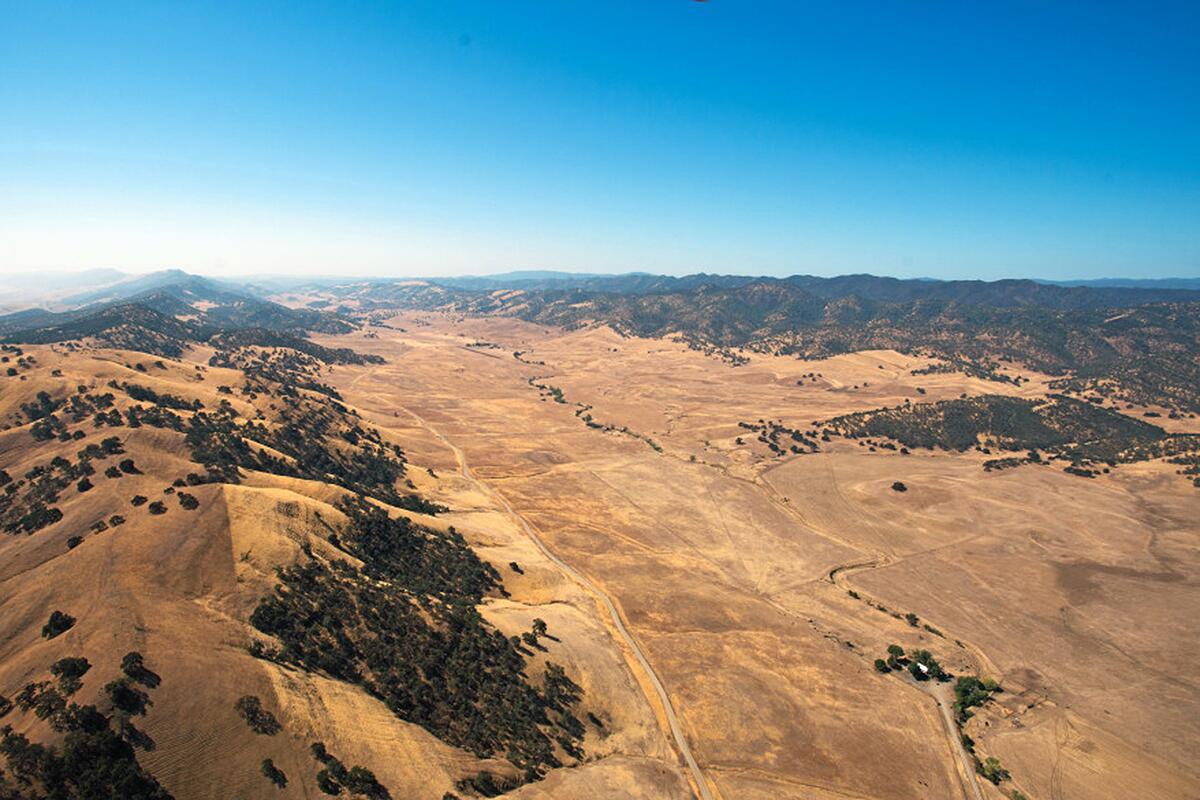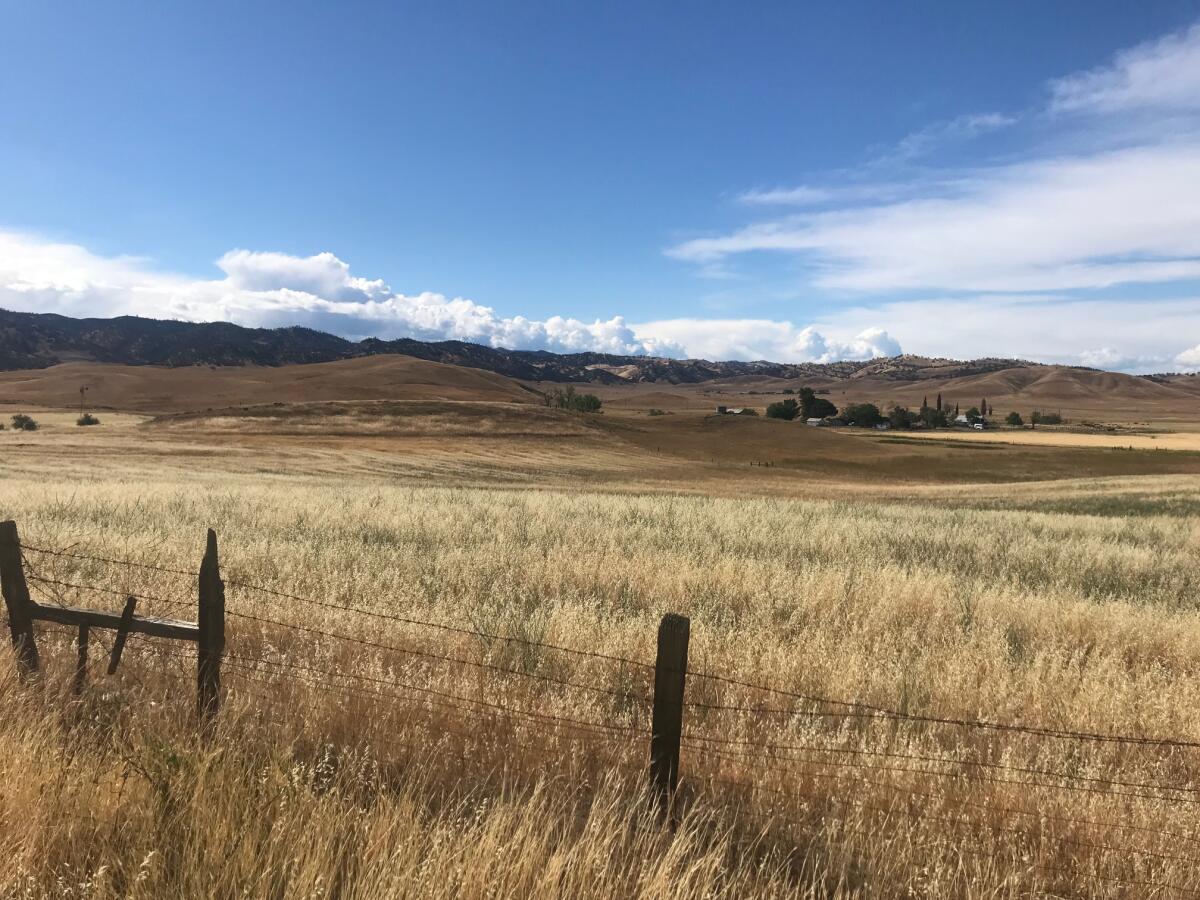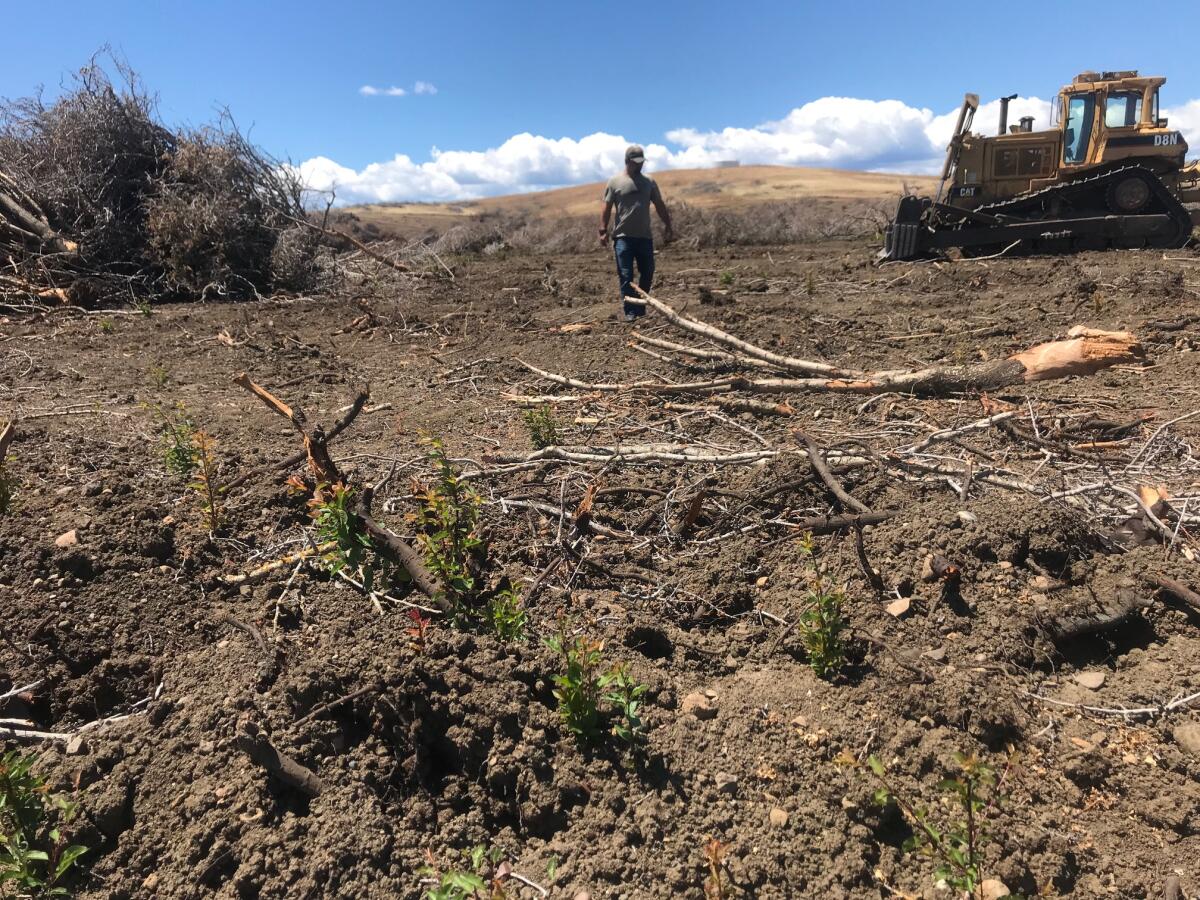California drought resurrects decades-old plan for controversial Sites Reservoir

- Share via
MAXWELL, Calif. — A long-dead proposal to flood a bucolic valley north of Sacramento and create a massive reservoir for thirsty Southern California is finding new life — and opposition — amid the effects of climate change and worsening drought.
First conceived in the 1950s, the Sites Reservoir project was abandoned in the 1980s — the twilight years of America’s big Western dam-building projects. Now, decades later, a Southwestern megadrought and historic water restrictions in Los Angeles, Ventura and San Bernardino counties are fueling renewed interest in the plan, much to the dismay of environmentalists.
Recently, the Metropolitan Water District of Southern California appropriated $20 million for project planning, saying the reservoir would make the region’s water supply more resilient in times of drought.
The proposal has also gained bipartisan support led by Gov. Gavin Newsom, $816 million from a voter-approved bond and more than $2.2 billion in loans offered by state and federal agencies.
“Drought is pushing this project forward,” said Rep. John Garamendi (D-Walnut Grove), a longtime supporter of the proposal. “We are in the third year of a serious drought, and the frequency of drought has shifted from every 10 years to every few years.”
Newsom echoed support for the plan.
“We’re actually going to get the project done,” Newsom said during a tour of Oroville Dam last month. The reservoir, he said, was “something I’ve long supported.”
The controversy has transformed the western Sacramento River valley into a battleground. Hardly a day goes by during which web pages of agricultural interests and petitions circulated by conservation groups don’t feature some divisive development or fiery comment.
The $4-billion off-stream reservoir is intended to hold storm water from the Sacramento River and would not dam the river or block fish migration. Operating under the public-private joint powers authority, it would contain, at capacity, 1.5 million acre-feet of water and would be available to investors for consumption, sale or lease. (An acre-foot of water is enough to supply three households for a year.)
But environmentalists say the reservoir will do little to solve Southern California’s water problem.
“Sites Reservoir won’t provide a lot of water — it will be costly, though, and hard to stop because it enables elected officials to say, ‘Look, we’re doing something about megadrought,’” said Ron Stork, senior policy advocate for the nonprofit Friends of the River. “It’s become their solution to climate change.”

Sierra Club California also warns that the reservoir, about 10 miles west of the small town of Maxwell and Interstate 5, would facilitate development of the controversial Delta Conveyance Project, a.k.a. the Delta Tunnel. That’s because, they say, it would help justify spending about $20 billion to move fresh water through the tunnel from Northern California to the San Joaquin Valley and Southern California.
Mike Conroy, executive director of the Pacific Coast Federation of Fishermen’s Assns., describes the reservoir proposal as “an expensive water grab that benefits California’s most wasteful water brokers, not average Californians.”
Yet in a region that is renowned for its bounty of rice, almonds, walnuts, pistachios and fruit trees, public sentiment for dams and reservoirs runs deep.
Billboards along Interstate 5 and State Route 99 proclaim, “Build Dams Now,” “Newsom stop wasting our dam water!” and “Irrigation matters.”
If permitted, the first major new reservoir built in California since 1999 would be owned and operated by a group of Central Valley agricultural interests and water districts.
Among 30 other beneficiaries, the Metropolitan Water District of Southern California would get the largest share of the reservoir’s water because it would pay the largest share of the project’s development costs.
The second-largest participant is the San Bernardino Valley Municipal Water District, which kicked in about $14 million, despite having robust supplies of water stored in its groundwater basins.
“When it comes to water, the great equalizer to all uncertainty is storage,” said Bob Tincher, the district’s chief water resources officer. “Of course, if we don’t need that water, we can always sell it to someone who does.”

The Sites project calls for the construction of two large dams up to 310 feet high, as well as nine smaller saddle dams. Storm surges from the Sacramento River some 15 miles away would be diverted to the reservoir via two existing canals and a new pipeline.
A key hurdle to the project’s completion is whether or not the California Water Resources Control Board will grant the reservoir permission to divert Sacramento River water.
“The board’s decision on our application will make or break this project,” said Jerry Brown, the authority’s executive director.
“If we don’t get the water right, there’s no project. If we get it, we’ll break ground in 2024 and be in full operation by 2030,” Brown said.
“Overall, we’re in pretty good shape,” Brown said. “Our comprehensive studies and modeling show that the Sacramento River has two to five times more available water than the 1.5 million acre-feet we’re seeking, even in drought conditions.”
But while investors wait it out, opponents including conservation groups, the salmon industry and tribal leaders warn that many important issues have yet to be decided by regulatory agencies and the courts.
Doug Obegi, director of the National Resources Defense Council’s California river restoration program, said the results are destined to define the terms of life along the river for its people, its landscape and endangered species including delta smelt and the storied but troubled chinook salmon.
“Right now, everyone is jockeying to get their hands on whatever water they can,” he said. “Farmers contend that harvesting the Sacramento River’s storm water is critical to their economic survival. Environmentalists argue those same surges are essential to sustaining the river’s ecological webs of life.”
Other critics include Jonas Minton, a former deputy director for the California Department of Water Resources and an expert on dam safety and flood management. To hear him tell it, “Sites Reservoir will never cross the finish line.”
“Politicians are promoting it because voters like dam proposals in extremely dry years,” he said. “But drought can also be disastrous to investors.”
That’s because, he said, when water supplies are low, those who own senior rights, such as Central California’s rice growers, get water before more junior right owners.
“All I see in the Sacramento Valley these days are fallow rice fields owned by farmers whose surface water deliveries have been slashed,” he added. “So, investors could find themselves with a right, but no actual water to put in their new reservoir.”

Sites Valley is a glimpse back in time — a great dusty bowl 13 miles long and about 5½ miles wide where cattle and deer browse grasslands framed by oaks and creeks that go dry in the brutal heat of summer.
It’s also home to 20 people, including Mary Wells, a respected former water manager and policymaker in Northern California, who has operated a cattle ranch in the valley for nearly half a century.
Wells and her children often hike and ride horses in the area. And as they wander out, they muse that in less than 10 years the entire valley could be underwater.
Wells has no beef with any of that. For her, it’s not a matter of whether to fill the valley with storm water, but how deep and how fast.
“The bitter part of it all is losing more monetarily and emotionally than anyone could ever imagine,” she said with a sigh. “The sweet part is knowing that this project is a thoughtful solution to the water crisis facing Central California agriculture and this amazing state.”
Critics point out that the reservoir would hold only a small fraction of the 42 million acre-feet of water consumed each year in California.
Steve Evans, a water consultant for conservation groups including the California Wilderness Coalition, worries that the reservoir’s diversions could disrupt the river’s ecology.
In one of environmentalism’s emerging successes, the Sacramento River National Wildlife Refuge is on the rebound because of restoration efforts.
Gazing out across expanses of rejuvenated riverbanks where wildlife has been moving back more quickly than expected, Evans said, “A reduction in the river’s annual surges means less vital habitat for bobcats, wood ducks, tree frogs and migrants including yellow-billed cuckoos.”
Still, there’s no escaping the anxiety among local farmers and ranchers cornered by climate change.
The Sacramento River watershed has been critically impaired by a third year of drought, with current storage in Shasta Lake, the state’s largest reservoir, at 1.7 million acre-feet, compared with the average 3.5 million acre-feet for this time of year, according to the California Rice Commission.
So far this year, 370,000 acres of crops have been fallowed on the western side of the Sacramento Valley, primarily in Colusa and Glenn counties, the commission said.
National wildlife refuges will receive only 15% to 18% of their usual water supplies late in the season. Reduced water for wildlife refuges and flooding rice farms could set the stage for botulism and avian cholera outbreaks.
Members of the Tehama-Colusa Canal Authority, a key participant in the reservoir project, don’t have to go far to find a lifeless signature of severe drought.
Just a stone’s throw beyond their boardroom windows are thousands of 18-year-old almond trees recently bulldozed by the group’s chairman, Zachary Dennis, because he couldn’t afford water to sustain them.
“I had no choice,” Dennis, 42, said, while tramping across the acreage to take stock of his losses. “Our water allocation dropped to zero, and the price of water from contractors jumped to $600 an acre-foot — about six times what it costs in normal years.”
Beyond that, the trees spread across 377 acres of land stopped producing almonds after the region was hit by frost in February.
“If it doesn’t rain appreciably this winter,” he said glumly, “there’s a good chance we’ll have to fall back on insurance.”







